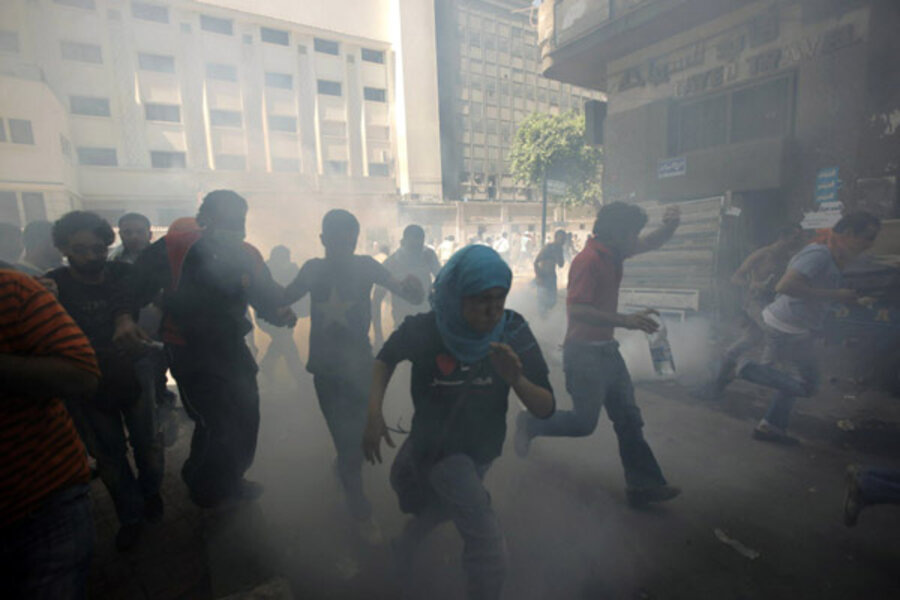The aftermath of another clash at Egypt's Tahrir Square
Loading...
| Cairo
Dozens of wounded file into a makeshift hospital tucked between buildings on Tahrir Square, the symbolic heart of Egypt’s five-month old revolution. They were coming from the scene of clashes between protesters and police that began in the twilight hours of Tuesday, and underscore the volatility of Egypt’s security situation in the nation’s transitional period.
“We just want to live in peace,” says Mahmoud Mohammad, a 15-year-old protester who was injured by rubber bullets in the clashes; he was one of several young men being bandaged up. Among other points of contention that include slow reform, the protesters called for faster prosecutions of the police who killed hundreds of demonstrators earlier this year and speedier trials of former corrupt officials, including former President Hosni Mubarak and former Interior Minister Habib al-Adly.
The speed with which a small protest snowballed into rioting and hours of clashes with the police, is a reminder of the potential for even greater volatility as Egypt's ongoing transition grinds forward. Security services used to violently suppressing dissent remain on the streets and some Egyptians are furious at the history of state torture and violence.
“If you have slow justice, people get angry – slow justice is injustice,” says a volunteer doctor who gave her name as Dina, just before she ran to a patient. The middle-aged man breathed in remnants of tear gas that lingered in downtown’s air.
Since the makeshift medical facility was erected this morning, hundreds of protesters have come in seeking treatment for wounds they received from policemen and burns caused by their mishaps with their own Molotov cocktails.
Wednesday’s clashes involving thousands of people snowballed following a planned memorial service in the Nile-side neighborhood of Agouza on Tuesday. Some witnesses say thugs incited the violence when the families of those who died in the revolution’s clashes marched down the street to the Balloon Theater and were denied access, but the details remain unclear. After yelling broke out, police began beating people and using tasers.
Shortly thereafter, protests began on the other side of the Nile on Mohammad Mahmoud Street, which intersects with Tahrir Square. Today the street was covered in broken rocks, shards of clear and green glass bottles, and dirt from crumbled rubble. The Ministry of Health said more than 1,000 people were injured in the clashes, at least 40 of them policemen.
Just folks
The protesters, who later marched on to the Interior Ministry, were not the usual crowd of activists who have frequently paraded through Tahrir Square demanding more reform. The demonstrators today were men and women, young and old, and were spread across social and economic spectrums – as one person at the hospital said, they were just “everyday Egyptians."
Rumors swirled on Wednesday afternoon that Minister of Interior Mansour el-Eissawi resigned following the violence, but the Interior Ministry denied the claim.
The security situation has been shaky since the start of the uprising. The Interior Ministry has made efforts to improve relationships between police forces and civilians. The Supreme Council of the Armed Forces, a body of senior military officers, has been ruling since Mubarak’s downfall on Feb. 11.
As clashes took place just a few blocks away from the site of the clashes, at a luxury hotel in Cairo’s Garden City, US Undersecretary of State for Political Affairs William Burns said in a round-table discussion that reform of Egypt’s security forces should be a top priority.
“Reform is obviously a very important priority and it’s a process that’s begun in some respects, a process that’s going to take time and a lot of effort on the part of the transitional government, but also elected governments,” he says.
The United States’s concern for a smooth transition toward democracy was highlighted by Senators John McCain and John Kerry, who visited Egypt last weekend and reaffirmed that the US wants to assist the country in economic and democratic reform.
The verdict in the case of Khaled Said, a 28-year-old businessman who protesters believe was tortured and killed by Alexandria policemen last year, is scheduled to be announced on Thursday, after having been delayed. Mr. Said's story was a rallying point for the Egyptian revolution, much as Mohammed Bouazizi, a street peddler who committed suicide after suffering police harassment, spurred the uprising in Tunisia.
A guilty verdict would be a symbolic victory, at least, for Egypt's democracy movement, and perhaps a sign that the era of impunity for the police might be coming to an end.
But some here fear that the verdict will be delayed again, heightening already bubbling-over tension.
“[Delaying the verdict] will provoke people more and more, and signify that no revolution happened at all – that some people were killed and murdered, and it’s just a normal thing,” says Mohammd Abdel Aziz, a lawyer who works with Egypt’s Nadeem Center for Human Rights.
Far from Tahrir and the rubble-ridden roads near downtown’s Interior Ministry, some Egyptians convey their aggravation with the ongoing instability. Nermine Hassan Sayyed, a 24-year-old Arabic teacher who lives 30 minutes by bus from central Cairo, wants life to go back to normal. “To where Egypt? I’m not optimistic,” she says, fed up with the violence.
[ Video is no longer available. ]





